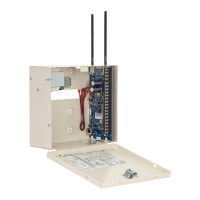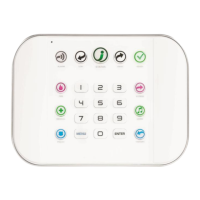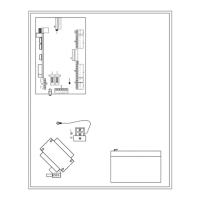
Do you have a question about the Interlogix xGenConnect NXG-4 and is the answer not in the manual?
| Keypads | 8 |
|---|---|
| Event Buffer | 512 events |
| Input Voltage | 16.5 VAC |
| Communication | IP |
| Battery Backup | 12 VDC, 7.0 Ah |
| Wireless Support | Yes (with optional receiver) |
Legal disclaimer regarding product use and damages.
Alerts users to potential risks and limitations of the system.
Outlines the terms and conditions of the product warranty.
General statement about the document's content and accuracy.
Specifies the proper and intended application of the product.
Describes hazards causing injury or loss of life.
Advises on possible equipment damage.
Advises on possible loss of time or effort.
Provides an overview of the xGenConnect system.
Details the system's capabilities and limits.
Lists and describes available product variants.
Details input voltage and current consumption for mains power.
Outlines voltage, current, and consumption for power supplies.
Lists the main functionalities of the system.
Specifies requirements for Ethernet network connection.
Describes the system's communication bus specifications.
Lists power draw for various system components.
Specifies current limits for output terminals.
Details battery backup current and capacity.
Lists operating temperature, humidity, and IP rating.
Provides physical specifications of the products.
Lists fuse types and ratings for system protection.
Provides guidance on system maintenance.
Explains how the system monitors its status and components.
Lists and describes standard alarm reporting codes.
Details requirements for compliance with alarm system standards.
Lists system settings that must be configured for EN 50131 compliance.
Describes features that can be enabled for enhanced functionality.
Advises on installation and programming for EN 50131 compliant systems.
Guidelines for applying compliance labels.
Discusses communication path monitoring and common system faults.
Lists components certified for specific security standards.
Details connections for the main NXG-8(E) panel.
Explains transformer and voltage/speaker output connections.
Describes wiring for both 2-wire and 4-wire smoke detectors.
Outlines wiring for single and doubled zones.
Detailed description of each terminal on the NXG-8(E) unit.
Explains the function of each LED indicator on the NXG-8(E) unit.
Visual representation of the NXG-9 unit's connections.
Detailed description of each terminal on the NXG-9 unit.
Explains the function of each LED indicator on the NXG-9 unit.
Visual representation of the NXG-4 unit's connections.
Detailed description of each terminal on the NXG-4 unit.
Explains the function of each LED indicator on the NXG-4 unit.
Specifies resistor combinations for detector end-of-line wiring.
Details power and cable specifications for the system.
Guidance on proper grounding procedures for system safety.
Instructions for connecting cable shielding to grounding points.
Explains the use of termination links for RS-485 bus.
Step-by-step guide for mounting the main system panel.
Instructions for inserting expansion modules into the enclosure.
Guidance on connecting antennas for wireless communication.
Specific instructions for installing antennas for wireless sensors and Z-Wave.
Guidance for installing antennas for the 4G/Wi-Fi module.
Description and installation guidelines for the plastic enclosure.
Description and installation guidelines for the metal enclosure.
Process for adding new devices to the system for programming.
Procedure for removing devices from the system's database.
Explains keypad tamper protection and lockout mechanisms.
Details arming procedures using the NXG-1820 keypad.
Details arming procedures using the NXG-183x keypad.
Explains how to disarm partitions using different keypads.
Details how to activate the SOS feature.
Describes using DLX900 for system programming.
Explains accessing system features via a web browser.
Details using the smartphone app for system control.
Outlines programming via the system keypad.
Explains user login and access levels for programming.
Describes setting up a WiFi access point for programming.
Details connecting DLX900 over a local network.
Details connecting DLX900 remotely via UltraSync.
Details connecting to the web server via Ethernet.
Troubleshoots LAN connection to the UltraSync service.
Describes using cellular/WiFi module for connectivity.
Troubleshoots 4G connection for UltraSync.








